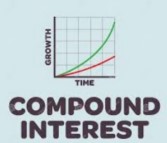Power of compound interest in my books
I suggest that friends read my book “The Rules of Super Growth Stocks Investing“:
- Sections 1-3, pages 36-44, a description of the entire section and a description of the examples
My book “The Rules of 10 Baggers“:
- Section 4-1, pages 188-192, on the relationship between frequent trading and compound interest.
- Sections 4-4, pages 214-218, on the relationship between portfolio rebalancing and compound interest.
- Section 6-1, 274 pages.
- Sections 6-7, pp. 317-336, on capital operations.
2019 Shareholder Letter
At the beginning of the 2019 shareholder letter, Buffett spent a considerable amount of space (in italics below), talking about the most important element of investment success, “the power of compound interest.”
In 1924, Edgar Lawrence Smith, an obscure economist and financial advisor, wrote Common Stocks as Long Term Investments, a slim book that changed the investment world. Indeed, writing the book changed Smith himself, forcing him to reassess his own investment beliefs.
Going in, he planned to argue that stocks would perform better than bonds during inflationary periods and that bonds would deliver superior returns during deflationary times. That seemed sensible enough. But Smith was in for a shock.
His book began, therefore, with a confession: “These studies are the record of a failure – the failure of facts to sustain a preconceived theory.” Luckily for investors, that failure led Smith to think more deeply about how stocks should be evaluated.
For the crux of Smith’s insight, I will quote an early reviewer of his book, none other than John Maynard Keynes: “I have kept until last what is perhaps Mr. Smith’s most important, and is certainly his most novel, point. Well-managed industrial companies do not, as a rule, distribute to the shareholders the whole of their earned profits.
In good years, if not in all years, they retain a part of their profits and put them back into the business. Thus there is an element of compound interest (Keynes’ italics) operating in favour of a sound industrial investment. Over a period of years, the real value of the property of a sound industrial is increasing at compound interest, quite apart from the dividends paid out to the shareholders.”
And with that sprinkling of holy water, Smith was no longer obscure.
It’s difficult to understand why retained earnings were unappreciated by investors before Smith’s book was published. After all, it was no secret that mind-boggling wealth had earlier been amassed by such titans as Carnegie, Rockefeller and Ford, all of whom had retained a huge portion of their business earnings to fund growth and produce ever-greater profits. Throughout America, also, there had long been small-time capitalists who became rich following the same playbook.
Nevertheless, when business ownership was sliced into small pieces – “stocks” – buyers in the pre-Smith years usually thought of their shares as a short-term gamble on market movements. Even at their best, stocks were considered speculations. Gentlemen preferred bonds.
Though investors were slow to wise up, the math of retaining and reinvesting earnings is now well understood. Today, school children learn what Keynes termed “novel”: combining savings with compound interest works wonders.
Munger’s view
“Understanding both the power of compound return and the difficulty getting it is the heart and soul of understanding a lot of things,” says Munger in typically grandiose terms. If you understand this truth, you will have a clear understanding of life and wealth, big and small.

Relative articles
- “The Compound Effect“
- “People who are good at deferred gratification is more likely to succeed“
- “Exponential growth can produce excess returns“
- “The power of compound interest“
- “Simple and compound interest calculator“
- “Why long-term investment is better?“
- “IRR Calculator“
- “Stocks are the best bet for long-term investors“
- “Investors should care annualized rate of return (IRR), How to calculate?“
- “The great enviable advantages of young people investing in stock“
- “Time, discipline and patience are the three elements of successful investment“
- “Patience, an indispensable element of investment success“
- “John Maynard Keynes, Investment master“
- “Warren Buffett’s Ground Rules“
Disclaimer
- The content of this site is the author’s personal opinions and is for reference only. I am not responsible for the correctness, opinions, and immediacy of the content and information of the article. Readers must make their own judgments.
- I shall not be liable for any damages or other legal liabilities for the direct or indirect losses caused by the readers’ direct or indirect reliance on and reference to the information on this site, or all the responsibilities arising therefrom, as a result of any investment behavior.